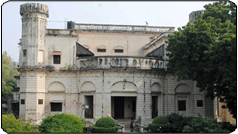Khursheed Manzil
The buildings of the Nawabs of Awadh are unique in a way that the material employed for them is just chunam (lime mortar) and lakhauri (thin flat bricks) with stucco used for their excellent decoration, it is not stone or marble, that was used by the Moghuls and earlier rulers in India. It is believed that this was done to reduce the cost of construction, because stone was not quarried anywhere in Awadh and getting this material from other parts of the country would have added transportation cost to the original cost, which in itself would be higher in case of stone and marble.
There is another peculiarity of the Nawabi buildings, particularly those built at Lucknow, it is their non-conventional following of any particular style. While some of the buildings are designed in the Indo-Sarcenic style in the Moghul fashion, many of them are built in the European style and quite often in a queer mix of both these styles, prevalent at the time.
Khursheed Zadi, the wife of the sixth Nawab of Awadh, Saadat Ali Khan and the mother of the seventh Nawab and first King of Awadh, Ghazi-ud-Din Haider has two buildings attributed to her name, a palace and a mausoleum, but interestingly, both have been buiit in different styles. While her mausoleum, built after her death by her son was fashioned in the Moghul style, the palace which was built in her lifetime by her husband followed the European style of a castle. The palace is named after her as Khursheed Manzil. It could not be completed in Saadat Ali Khan's lifetime and was completed by his son Ghazi-ud-Din Haider in 1818.
Khursheed Manzil was built adjacent to the Moti Mahal, a palace built by Saadat Ali Khan. The design and construction of Khursheed Manzil was done by Captain Duncan Mc Leod who was in the service of the British East India Company in 1911 when he was lent to the Nawab for supervising the repairs and construction of his buildings and for surveying the river, for suggesting a suitable site for an iron bridge. Captain Mc Leod, to some extent, followed the design of one Robert Smith, who had conceived for the reigning Nawab, a two storeyed building having a large central dome and eight very distinctive octagonal towers, rising to the whole height of the building, topped with battlements. He also borrowed certain features like the moat and drawbridge from the buildings of the French entrepreneur. (Major General) Claude Martin e.g. the Constantia and his town house, later known as Farhat Bakhsh.
Captain Mc Leod was offered employment by the Nawab in 1813 at a salary of rupees one thousand five hundred per month with free furnished accommodation and posse of servants as perks. Later, he resigned his job with the Company to remain in the exclusive service of Nawab Saadat Ali Khan. The Nawab spent rupees five thousand for providing seven out-houses for kitchen attached to the grand residence of his coveted engineer. After Saadat Ali Khan's death, Nawab Ghazi-ud-Din Haider, further raised the salary of Captain Mc Leod to rupees two thousand per month.
Khursheed Manzil with its hexagonal towers, battlements, moat and drawbridge is quite similar to an English Lord's castle. It also served as a guest-house, where Ghazi-ud-Din Haider invited his foreign visitors for breakfast and tea. Governor General Lord Moira, the Marquis of Hastings visited the Khursheed Manzil in March 1818, soon after it was completed. He refers to it as the 'Palace of Sun', since Khursheed means 'sun' in Persian.
Later, when the second King of Awadh, Naseer-ud-Din Haider planned an astronomical Observatory, Tare wali Kothi, Captain Herbert was appointed its astrono-mer in 1832 and Khursheed Manzil being adjacent to the Observatory, became the residence of Captain Herbert so that he could watch the heavens whenever he liked, in the day or night.
During the freedom struggle of 1857, the building was in control of the rebels (freedom fighters) and was used by them as their headquarters. Their leader, Ahmad-ullah Shah of Faizabad held his Court in Khursheed Manzil [according to an English lady's acccount who stayed here for some days as captive of a rebel commander].
Khursheed Manzil was recaptured by the British on November 17,1857 through a three pronged attack, led by the Generals, Outram and Havelock and their Commander-in-Chief, Colin Campbell. The three jubilantly shook hands when they met at the castle palace on that significant occasion.
Under the charities of the French, Major General Claude Martin (died 1800), the British administration in 1869 decided to utilise part of its funds to establish an exclusive institution for the education of European Christian females in the city. Their search for a suitable building ended, when Khursheed Manzilwas presented to the La Martiniere management by the British government in 1871.
Thus, Khursheed Manzil, the palace initially meant for a Begum of the Nawab of Awadh, got converted to an exclusive European Public School. It is now recognised as the La Martiniere College for girls and is today a prestigious institution for girls in the city.
Source:
HindustanTimes, City Scan, A Time in History
Wednesday 7.1.1998 — Khursheed Manzil - From a Queen's palace to citadel of learning

